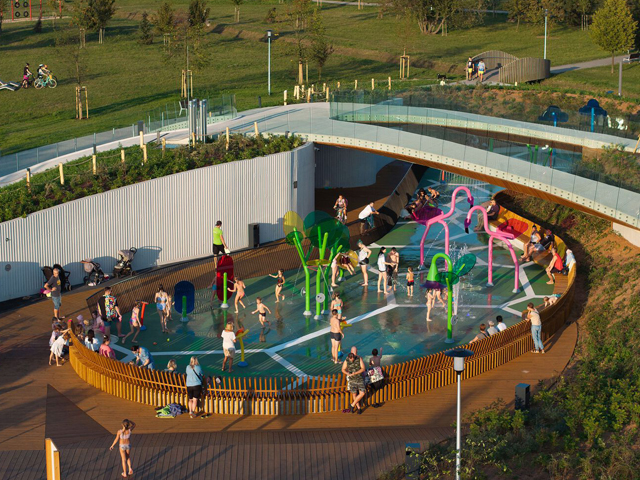AN ENGINEERED PERSPECTIVE
31 Aug 2016
Meet Richard Ellis, inhouse structural engineer for KOMPAN, and find out why engineering is integral to playground construction and how this helps KOMPAN remain a leader in the industry.

Meet Richard Ellis, inhouse Chartered Structural Engineer for KOMPAN Australia. Richard joined the KOMPAN team in July 2014.




Can you tell us a bit about your background and experience before KOMPAN?
I completed my Bachelor’s degree in Auckland, NZ in 2002, then moved to Australia (actually my country of origin) and went to work in Mt Isa. Since then I’ve completed a number of postgraduate papers and project management courses in Australia. I’ve also been all around Central Queensland, Brisbane, and internationally, designing everything from housing extensions to shopping centres, to major power plants. I achieved Chartered Status and RPEQ in December 2010.
How do you as a structural engineer add value to customers?
Well firstly from a legislative point of view, all States and Territories of Australia require new or modified buildings or structures to comply with the Building Code of Australia. This includes mandatory structural integrity performance provisions to ensure all users of the equipment are safe from injury caused by structural failure. So it is extremely important that a professional engineer takes the time to properly assess all components of a structure. Owners of playground equipment have to be confident that not only does their equipment (and surrounding softfall) comply with AS 4685, but fundamentally the structure can take the battering, bruising, and often very heavy loads subjected to it, for the lifetime of the product. The steel in KOMPAN products is warranted for life.
From a play point of view, having a dedicated engineer on board that works solely in playgrounds, is trained in playgrounds, and works closely with Landscape Architects, developers, schools and councils across Australia, helps bring these phenomenal projects from concept to reality. But even though I do help assess our products for compliance, we have third party inspectors to certify customised equipment onsite.
What are some of the challenges a structural engineer faces?
Playgrounds are often sited in parklands that aren’t suited for structures. They may be flood-prone, be a heritage area (meaning minimally disturbing the site), and I have even had to design footings to go literally into a covered up decommissioned landfill.
But regardless of what the site is or was before, the new play structures in demand these days are getting bigger and better, pushing the limits in terms of size, play value and cost competitiveness. Then factor in the wide range of Australian conditions and climates in general – sandy soils, highly reactive black soil, inland deserts and high humidity, cyclones etc, then long-lasting and good-looking playgrounds for all age ranges takes a lot of thought.
What issues do you feel Landscape Architects face today, and what would you like to see done to overcome them?
I think a significant challenge in today’s environment is creating playground ‘landmarks’. Play structures these days aren’t just about kids having fun, they can actually make a statement for the whole community. So combining play and safety with structures that have a striking look, are sculptural, or natural and organic, and often 3 storeys high, is a real challenge for both architects and playground designers.
How does nature play and designing for natural elements factor into your work?
Nature is a fundamental part of play, so designing in and around natural elements is a core focus in our playground design. Children also require challenges, so we are also mindful that the two need to work hand in hand. From a structural perspective, strength and serviceability take up a big part of my day. I spent a lot of time going through our timber ranges, analysing and assessing the units against the Australian timber standards. It is a challenge because the ranges have that natural variability, and you have to factor in the naturally occurring knots and cracks that occur in timber. It gives the timber the natural look and feel, but can be a headache when assessing strength!
KOMPAN products are all robust though and stand up to the applied loads with no worries. Again, we are seeing tall custom timber structures designed as well, and combinations of steel and timber that are all run past me. Sometimes there are small structural braces here and there that make all the difference between a project that works and a project that doesn’t.
What can we expect to see from the booming outdoor fitness market?
KOMPAN have just released a fantastic new fitness range which is the first in Australia to be designed specifically for adults and comply with the European Standard EN 16630 Outdoor Fitness Equipment. For example, the weight design of the fitness range has increased to 99kg, from 69.5kg in AS4685. There are also further requirements for moving parts, braking, dampening etc… but importantly the European Standard still has the safety requirements of AS 4685 so you can put it near a playground and if children use it, it will be fine. KOMPAN initiated the proposal in conjunction with David Eager from the University of Technology Sydney and Chair of the Australian Standards Committee CS-005 to adopt the European Standard in Australia. This will be a landmark implementation as the outdoor fitness industry continues to boom and I am proud to say that I have been personally involved in the project. The market has already reacted positively to our fitness equipment installed, and I’ve had numerous councils offer their support in the setting up of Australia’s very own fitness standard. I’m keen to see more dedicated fitness areas out there in our parks, so it’s great to work for a company that’s at the forefront of playground (and fitness) design.

MORE NEWS

MAKING A SPLASH

PLAYGROUND CELEBRATING ASH BARTY A GRAND SLAM

HOW TO ENSURE YOUR DESIGN COMPLEMENTS THE SURROUNDING ARCHITECTURE

CHINA'S NEWEST ARIA: THE HUACHIAO VIBRANT SPORTS PARK

5 IDEAS HOW TO USE PLAY SPACE SLOPES TO YOUR ADVANTAGE

